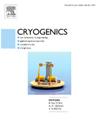A quantum-corrected Peng‒Robinson equation of state for helium-4 from 3 K to 50 K considering quantum swelling effects through the Feynman‒Hibbs correction of the EXP-6 potential
IF 1.8
3区 工程技术
Q3 PHYSICS, APPLIED
引用次数: 0
Abstract
Accurate and efficient prediction of the properties of helium-4 (He-4) via an equation of state (EOS) is a prerequisite for evaluating liquid helium-4 (LHe-4) storage technology. However, the performance of the Peng–Robinson (PR) EOS in predicting the density of LHe-4 and vapour helium-4 (VHe-4) deteriorates within the thermodynamic ranges of the LHe-4 tank: 3–50 K and 60–600 kPa. To modify the PR EOS, we establish first-order and second-order Feynman–Hibbs (FH)-corrected EXP-6 potentials and propose a reduced effective particle diameter (REPD) correlation with four parameters to consider the quantum swelling effects of LHe-4. On the basis of the rational function form of the REPD correlation, we introduce a quantum-corrected covolume term to develop a regression model for the FH-corrected Peng–Robinson (FH-PR) EOS. Moreover, to improve the effectiveness of regression near the saturation curve, we propose a hypothetical boundary consisting of the saturation curve from 3 K to the critical temperature and a virtual saturation curve from the critical pressure to 600 kPa. The results indicate that the FH − PR EOS shows satisfactory engineering application performance in predicting the density of He-4 within the studied range. Under verification conditions, the average absolute relative deviation (AARD) of the density determined via the FH − PR EOS ranges from 0.72 % to 1.77 %, and the maximum relative deviation (MRD) ranges from 2.17 % to 5.62 %. Under test conditions, the AARD of the density ranged from 1.06 % to 1.71 %, and the MRD ranged from 3.77 % to 7.38 %.
通过对 EXP-6 势的费曼-希布斯修正,考虑量子膨胀效应的氦-4 从 3 K 到 50 K 的量子修正彭-罗宾逊状态方程
通过状态方程(EOS)准确有效地预测氦-4(He-4)的特性是评估液氦-4(LHe-4)存储技术的先决条件。然而,彭-罗宾逊(PR)状态方程在预测液氦-4 和蒸气氦-4(VHe-4)密度方面的性能在液氦-4 储罐的热力学温度范围内每况愈下:3-50 K 和 60-600 kPa。为了修改 PR EOS,我们建立了一阶和二阶费曼-希布斯(FH)校正 EXP-6 势,并提出了具有四个参数的有效粒子直径缩小(REPD)相关性,以考虑 LHe-4 的量子膨胀效应。在 REPD 相关性的有理函数形式的基础上,我们引入了量子校正的共体积项,为 FH 校正的 Peng-Robinson (FH-PR) EOS 建立了回归模型。此外,为了提高饱和曲线附近的回归效果,我们提出了一个假设边界,包括从 3 K 到临界温度的饱和曲线和从临界压力到 600 kPa 的虚拟饱和曲线。结果表明,FH - PR EOS 在研究范围内预测 He-4 密度的工程应用性能令人满意。在验证条件下,通过 FH - PR EOS 测定的密度的平均绝对相对偏差 (AARD) 在 0.72 % 到 1.77 % 之间,最大相对偏差 (MRD) 在 2.17 % 到 5.62 % 之间。在测试条件下,密度的 AARD 在 1.06 % 到 1.71 % 之间,MRD 在 3.77 % 到 7.38 % 之间。
本文章由计算机程序翻译,如有差异,请以英文原文为准。
求助全文
约1分钟内获得全文
求助全文
来源期刊

Cryogenics
物理-热力学
CiteScore
3.80
自引率
9.50%
发文量
0
审稿时长
2.1 months
期刊介绍:
Cryogenics is the world''s leading journal focusing on all aspects of cryoengineering and cryogenics. Papers published in Cryogenics cover a wide variety of subjects in low temperature engineering and research. Among the areas covered are:
- Applications of superconductivity: magnets, electronics, devices
- Superconductors and their properties
- Properties of materials: metals, alloys, composites, polymers, insulations
- New applications of cryogenic technology to processes, devices, machinery
- Refrigeration and liquefaction technology
- Thermodynamics
- Fluid properties and fluid mechanics
- Heat transfer
- Thermometry and measurement science
- Cryogenics in medicine
- Cryoelectronics
 求助内容:
求助内容: 应助结果提醒方式:
应助结果提醒方式:


